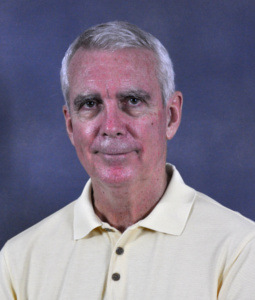Department of Chemistry and Biochemistry
Students, Researchers and Emeritus
Daniel L. Reger
| Title: | Carolina Distinguished Professor Emeritus Inorganic / Organometallic / Supramolecular |
| Department of Chemistry and Biochemistry | |
| Email: | reger@mailbox.sc.edu |
| Phone: | 803-777-2587 |
| Fax: | 803-777-9521 |
| Office: | Office: GSRC 509 Lab: GSRC 512, 803-777-4241 |
| Resources: | CV [pdf] All Publications Department of Chemistry and Biochemistry |

Education
B.S., 1967, Dickinson College
Ph.D., 1972, Massachusetts Institute of Technology
Honors and Awards
Carolina Distinguished Professor Emeritus, 2016; Southern Chemist Award, Memphis Section of the American Chemical Society, 2013; Charles H. Stone Award, Charlotte/Piedmont Section of the American Chemical Society, 2011; Fellow of the American Association for the Advancement of Science, 2011; American Chemical Society Outstanding South Carolina Chemist of the Year, 2008; University of South Carolina Educational Foundation Outstanding Service Award, 2008; South Carolina Governor's Award for Excellence in Scientific Research, 2007; Michael J. Mungo Award for Excellence in Graduate Teaching, 2003; Carolina Trustee Professorship, 2000; Amoco Foundation Outstanding Teaching Award, 1996; Michael J. Mungo Award for Excellence in Undergraduate Teaching, 1995; USC Educational Foundation Research Award for Science, Mathematics, and Engineering, 1995.
Research
Inorganic chemistry. Synthesis of third generation poly(pyrazolyl)methane and poly(pyrazolyl)borate ligands and ligands containing aromatic groups that form strong π-π stacking interactions; preparation of metal complexes of these ligands that have unusual magnetic and structural properties.
Our group is the leader worldwide in the development of the chemistry of tris(pyrazolyl)methane ligands. These ligands, the neutral analogs of the extensively investigated, isoelectronic tris(pyrazolyl)borate ligands, were not studied extensively prior to our work because they were difficult to prepare. We have now dramatically improved these preparations making the whole family of HC(3-Rpz)3 (pz = pyrazolyl ring;R = Ph, Pri, But) ligands and HC(3,5-Me2pz)3 readily available for the first time. We have functionalized these new ligands to prepare a number of new polytopic ligands (those with multiple pol(pyrazolyl)methane units in a single molecule), a development that represent the first major effort to prepare “third generation” poly(pyrazolyl)methane ligands. Third generation ligands are specifically functionalized at the non-coordinating, “back” position, distal from the metal environment, for the purpose of appending new/desired functionality into the systems under study while not impacting the direct environment about the metal.
We have developed unusual chemistry of many different metal system with these ligands. A particularly exciting example is the reaction of M(BF4)2 compounds with Lm resulting in fluoride abstraction leading to the complexes [M2(u-F)(u- Lm)2](BF4)3 (see figure 1 for M = Fe structure) in which a single fluoride ligand and two Lm molecules bridge the two metal centers. The M = Fe complex shows weakly antiferromagnetic behavior.
In a separate project we have used tris(pyrazolyl)methane ligands to prepare new iron(II) complexes that show very unusual spin properties. The complex {[HC(3,5-Me2pz)3]2Fe}(BF4)2 is fully high spin from 350 K to 206 K then undergoes an abrupt spin change to a mixture of high and low spin forms, an unprecedented result. It also undergoes a solid-state phase change at 206 K, a change we have observed for other analogous complexes of first row metals showing that the phase change drives the spin-state change. In recent work we are studying the effects of controlling spin-crossover effects by manipulating the supramolecular structures of the compounds. We have synthesized a new family of “third generation” poly(pyrazolyl)borate ligands. Using these ligands we have been able to show that subtle changes in either molecular or supramolecular structure can greatly influence the spin-crossover behavior of iron(II) complexes. The figure shows the three dimensional structure of one polymorph of Fe[(p-IC6H4)B(3-Mepz)3]2 where the highly organized structure prevents the molecules from undergoing spin crossover at low temperature.
Incorporating the 1,8-naphthalimide group into bis(pyrazolyl)-methane ligands allows the asscoiation of their metal complexes into directionally ordered dimers by strong π-π stacking interactions in both solution and solid-state, as pictured. The incorporation of this π-bonding group into acetate ligands leads to the formation of paddlewheel metalladimers with very unusual supramolecular structures held together by non-covalent forces, as pictured in Figure 2.
Selected Publications
“Syntheses, Structural Correlations, Antiferromagnetic Superexchange Interactions and Electron Paramagnetic Resonance Studies of Dinuclear Metallacycles with Single M-X-M Bridges (X = Cl-, Br-; M = Fe(II), Co(II), Ni(II), Cu(II), Zn(II), Cd(II))” Inorg. Chem. 2017,56, 2884-2901, D. L. Reger, A. E. Pascui, E. A. Foley, M. D. Smith, J.Jezierska, A. Wojciechowska, S. A. Stoian and A. Ozarowski.
“Metal Complexes of Multitopic, Third Generation Poly(pyrazolyl)methane Ligands: Multiple Coordination Arrangements,” Eur. J. Inorg. Chem. 2016, 2253-2271, R. F. Semeniuc and D. L. Reger.
“Supramolecular Metal-Organic Frameworks of s- and f-Block Metals: Impact of 1,8-Naphthalimide Functional Group,” Cryst. Growth Des. 2016, 16, 527-536, D. L. Reger, A. P. Leitner and M. D. Smith.
"Homochiral, Helical Coordination Complexes of Lanthanides(III) and Mixed Metal Lanthanides(III): Impact of the 1,8-Naphthalimide Supramolecular Tecton on Structure, Magnetic Properties, and Luminescence," Cryst. Growth Des. 2015, 15, 5637-5644, D. L. Reger, A. Leitner, and M. D. Smith.
Reger, D. L.; Pascui, A. E.; Smith, M. D.; Jezierska, J.; and Ozarowski, A. Syntheses, Structural, Magnetic and EPR Studies of Monobridged Cyanide and Azide Dinuclear Copper(II) Complexes: Antiferromagnetic Superexchange Interactions. Inorg. Chem. 2015, 54, 14870 - 1500.